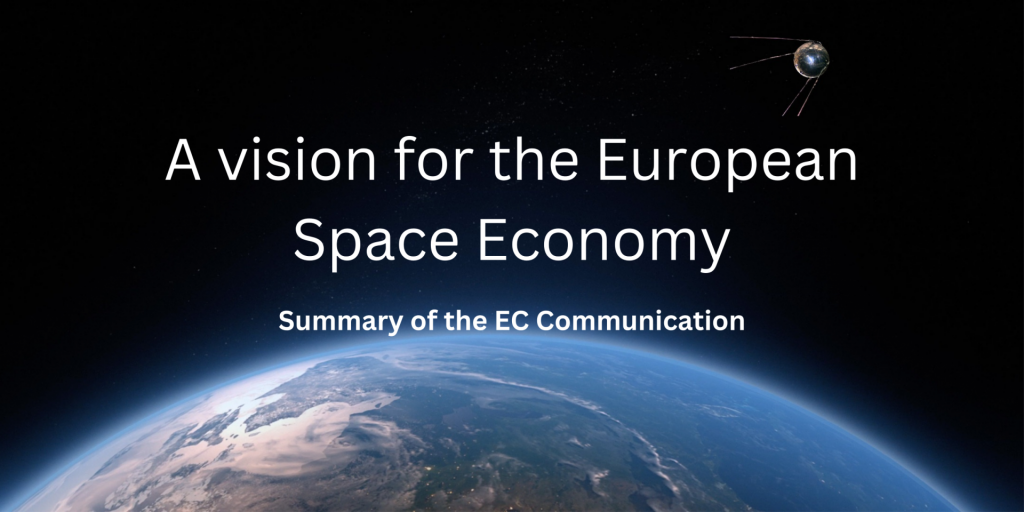
- Category: Library
- 2025-06-30
On 25 June 2025, the European Commission adopted the Communication “A Vision for the European Space Economy”, a strategic roadmap to position the European Union as a sovereign and globally competitive space power by 2050. The document explains how Europe should respond to intensifying global competition, rising demand for space-based services, and the increasing importance of digital technologies in the space sector.
For the downstream segment of the space economy, the Communication offers a clear institutional acknowledgement: the EU is not yet fully exploiting the economic potential of its own space infrastructures. Despite having world-class systems such as Galileo, Copernicus, and IRIS², Europe captures only 19% of the global downstream market. This lags behind its 33% share in upstream non-captive markets and highlights a gap between infrastructure investment and commercial service delivery.
To address this, the Commission outlines a strategic framework organised around six “building blocks,” several of which directly impact the downstream sector. The first is the creation of a Single Market for Space, to be formalised through the forthcoming European Space Act. This legal initiative shall simplify and harmonise rules across Member States, reduce administrative burdens, and allow space operators, both upstream and downstream, to scale and compete more effectively across borders.
Another key measure is aimed at strengthening space commercialisation, with emphasis on agile procurement, anchor customer contracts, and targeted investments. The Commission identifies public procurement as a critical tool to support the uptake of space services. It proposes modern approaches such as Dynamic Purchasing Systems, Central Purchasing Bodies, and Onboarding Schemes to make procurement more accessible and innovation-friendly. These instruments are intended to give a foothold to new entrants and SMEs, enabling faster scale-up and greater market credibility.
In terms of investment, the Commission commits to expanding the CASSINI initiative by establishing a Seed Investment Facility, a Growth Investment Facility, and a Debt/Non-dilutive Financing Facility. It will also launch a pilot to select venture capital funds under CASSINI to attract more private investment into the space economy. These actions are designed to address Europe’s persistent funding gap in scaling high-risk, capital-intensive satellite-based ervices.
The Communication also recognises the central role of digital infrastructure in enabling downstream services. It highlights the importance of data storage, real-time processing, and cloud-based platforms for delivering modern applications. The Copernicus Data Space Ecosystem (CDSE) is cited as a flagship example of how open, cloud-enabled platforms can support scalable Earth observation services. To address dependencies on non-EU systems, the Commission anticipates action through the Cloud and AI Development Act, which aims to triple EU data centre capacity and strengthen the use of sovereign EU-based infrastructure.
Use cases for downstream applications are mentioned throughout the Communication. It mentions contributions to transport and mobility, agriculture, energy, environmental monitoring, and crisis preparedness, while encouraging further integration of space services into sectoral policies. The Commission also commits to supporting better interoperability across infrastructures and user terminals, ensuring that space solutions are embedded into the broader digital economy.
The Communication also acknowledges the need to develop a highly skilled workforce in the space sector. It mentions digitisation and automation as key drivers for productivity and efficiency and calls for actions to build sectoral training capacity, particularly in cooperation with Member States and the private sector.
Lastly, the Commission addresses international cooperation as a structural pillar for downstream market development. It supports the promotion of EU industry in international procurement, greater visibility in trade dialogues, and actions to remove market access and standardisation barriers abroad. These are aimed at improving the global competitiveness of European space service providers.
The Communication does not introduce a standalone industrial strategy for the European downstream space sector, as requested by Space Y in its position paper. Nevertheless, it does indicate the necessary regulatory, financial, and policy actions that are needed to strengthen the sector. If implemented effectively, these measures could enable Europe to fully exploit its EU Space Programme to create value for civil society and economic growth for Europe.
The full communication is available here: https://eur-lex.europa.eu/legal-content/EN/TXT/HTML/?uri=CELEX:52025DC0336